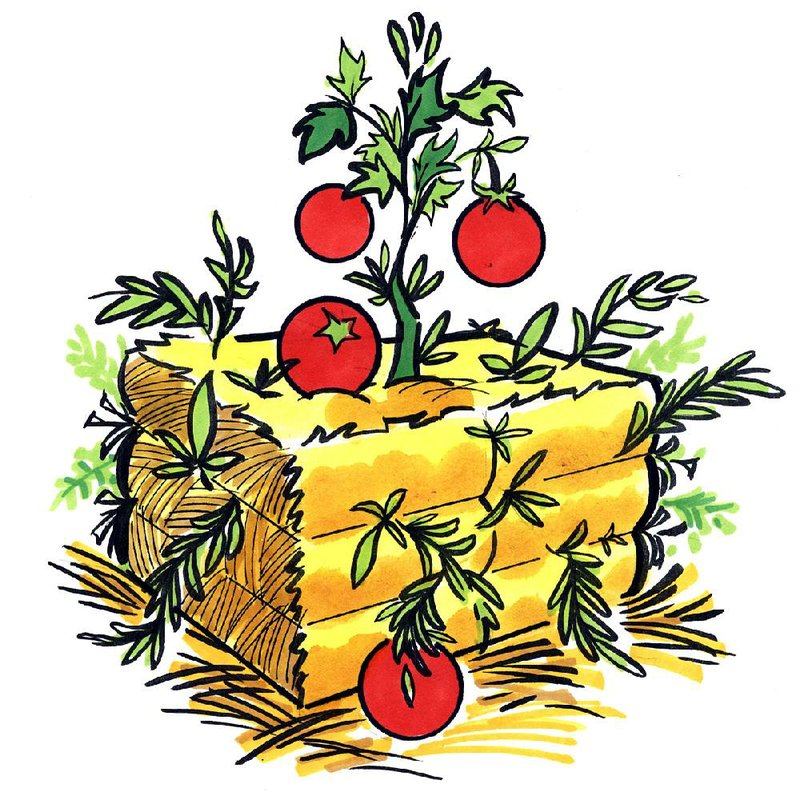Q We recently moved to Jacksonville in Pulaski County and would like to plant a garden. However, the soil is very rocky. I have seen various layouts for gardens using bales of straw. The articles specifically say you should use straw, not hay. Do you have any suggestion as to where to get bales of wheat straw? Also, do you have suggestions on how to best start a bale garden?
A Growing vegetables in bales of wheat straw is gaining in popularity and does work, but I think the annual maintenance could be reduced by just building some raised beds and adding good soil. I have many raised-bed gardens, and I garden pretty much year-round in them. Wheat straw bales should be available from most farm supply stores. Before planting in them, you saturate the bales for a few days. Some people just plant in the bale, while others add a bit of bagged garden soil into the center. Bale gardens need regular water and fertilization to keep the plants growing. Bales will dry out faster than garden soil, so pay attention. One benefit is you start over every year, so diseases don't have a chance to build up in the soil; but the downside is you do have to bring in new bales every year. Whether you grow in bales or build raised beds, make sure the location has at least six hours of sunlight per day and a readily available water source.
Q I live in Maumelle and just put in a raised garden plot that measures 4 feet wide by 30 feet long. I would like some information on when and what to plant that would maximize this space. I would like tomatoes, peppers and lettuce, etc.
A Raised beds are the way to garden when you have rocky soil. Raised beds allow you to bring in great soil to give your plants a good start. We have several seasons for vegetable gardening in Arkansas. Right now we are a bit early to plant, but in a few weeks you can begin to plant English peas and greens. By mid- to late February, transplants for broccoli, cabbage and cauliflower will be arriving at garden centers. We plant cool-season vegetables from February through mid-April, and then the warm-season vegetables, including tomatoes and peppers, along with squash, corn and green beans from mid-April through June. We can then plant a fall garden. The website of the University of Arkansas' Division of Agriculture's Cooperative Extension Service has a great calendar of planting dates. At uaex.edu, search for "vegetable planting calendar."
Q I have some loropetalum bushes in my flower bed that grew like weeds. I could not keep up. I would like to replace them with a short, small shrub that won't require monthly trimming, maybe even a ground cover.
A There are many varieties of loropetalum. Some can become small trees, while others are much shorter. "Purple Pixie" is very small and slow growing, while "Ruby" gets 3 to 5 feet tall. I would assume you are looking for an evergreen for the sun, since you have loropetalum, so some dwarf options would be one of the low-growing hollies -- dwarf yaupon or a "Soft Touch" compacta holly, a dwarf abelia or rockspray cotoneaster. You could also grow rosemary, either an upright or a prostrate variety. Rosemaries are evergreen and can be used in the kitchen as well as the flower bed.
Q Do you have information to show me how to trim a crape myrtle tree? Thanks for any help. The yard men will probably start as soon as the weather cooperates, and I want to have them pruned correctly.
A I like to leave three to five main trunks on standard crape myrtles and allow them to become graceful, mature trees. Topping them or cutting them back to those ugly knobs is not the correct way. There is a video on our website that describes the different types of pruning cuts. At uaex.edu, search for "crape myrtle pruning."
Janet B. Carson is a horticulture specialist for the University of Arkansas Cooperative Extension Service. Write to her at 2301 S. University Ave., Little Rock, Ark. 72204 or email her at
jcarson@arkansasonline.com
HomeStyle on 01/24/2015
